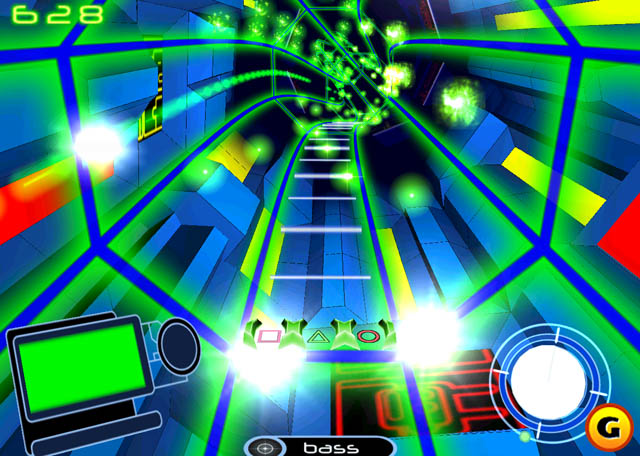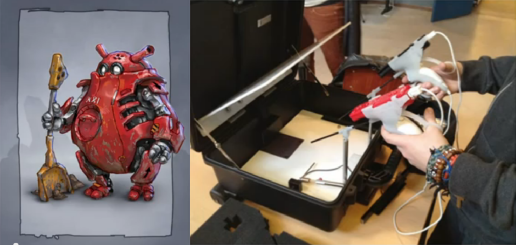Fighting Indecision (And So Much More) with Games

While these specialized games may fulfill very specific functions, there’s an ocean of possibilities to leverage this power to effect meaningful change through ordinary videogames with no overt agenda. Even better, the changes that result from playing ‘normal’ games might be more lasting than from specialized experiences.
Here’s an example. Frequency is a music rhythm game that came out in 2001 for the PlayStation 2. The concepts it introduced became the foundation for what would become the Guitar Hero series. So what kind of behavioral change could a music game possible incite?
I certainly didn’t see it coming. But through consistently playing the game, I slowly realized that Frequency was helping me overcome a severe habit of indecision.
Up until that point, I was pretty terrible at making decisions of any kind. I’d constantly weigh the benefits of each option over and over, trying to find the slightest reason why one choice was better. I couldn’t pick which movies to see, which restaurants to go to, even which games to play. And then I started playing Frequency.

In the game, you’re constantly progressing forward down a ‘note highway’ as in Guitar Hero. Yet instead of a flat plane like in those games, this is more like an eight-sided note tube, with each surface representing a different instrument. As you played and the song continued, you automatically sped down the tube, rotating to select which surface/instrument to play.
Here’s why it worked: In order to beat the harder levels (and later on, to get the highest scores), you had to instantly make a decision to pick the next instrument track, and then do it immediately. There was no time to weigh the benefits of each side; you just had to pick something and stand by it. Over time, this truism started to sink in to the point where I found myself less caught up in the minutiae of everyday decisions. I had become more decisive in life because I had played this game.
The reason this worked is simple – the ability in question, making decisions, was a necessary skill in order to excel at playing the game. Without overt prodding or explicit instructions, it became apparent that my reluctance to change was competing with what the game wanted me to do – and my desire to keep playing helped overcome that reluctance.
The answer is so simple, yet it seems that this hasn’t really been absorbed by the development community. For serious game developers working with clients, it could be that the stakes are too high to even consider non-traditional approaches. Yet serious games that wear their messages on their sleeves run the risk of diluting the potency of the desired change or message because they’re so obviously trying to force a specific result, while we as humans depend heavily on subtext, body language and non-obvious cues for our information.

Though there are benefits in trying new approaches. Take the case of Grendel Games, a developer of serious and entertainment games in the Netherlands. When asked to come up with a game to train surgeons for laparoscopic surgery, the developers noted that existing training methods were technically effective, but too boring to be used regularly.
Sure, surgeons could practice the same motor skills used in the procedure, but after a day of operations and working in the hospital, doing a pure skills workshop was the last thing they’d want to spend their free time doing.
Taking a different approach, the developers instead proposed a more traditional game, complete with a fictional world, little monster characters, respectable production values and a narrative premise that tied in with the input device (Wii remotes hooked up to a custom controller handle). The game is still in development, but it’ll be worth checking up to see if their approach bears fruit.
The thing is, any game can be designed to include behavior-affecting components. The key is simple: tie the desired behavior into gameplay loops that require it to progress. This means that the user can’t get around adapting to the new behavior by trial and error, or through frequent saving and loading cycles. In Frequency, decisions are required every 1-2 bars of music, or roughly every 4-8 seconds, making it impossible to play at higher levels without being able to make quick decisions.
So what other behaviors can we address through regular games? Here’s a few to consider:
Forgetfulness. Instead of rote training like Nintendo’s Brain Training series, require players to recall specific information while playing the game. In an RPG, this could take the form of remembering specific topics to talk to other characters about (instead of choosing from preselected options), or in a sports game, prompt players to choose the best strategy from a wide selection of plays.

Learned Information. Avoiding the didacticism of most educational titles, consider making the specific information you want to teach relevant to core gameplay. For example, people who play lots of FPS games tend to have a base knowledge of different types of guns, their respective clip sizes, reload speeds and stopping power, even if they’ve never even held one. Integrate the information you wish the player to retain across all commonly used aspects of your game to help create a similar effect.
Learned Techniques. Instead of purely instructional scenarios, look for ways to implement the desired techniques into gameplay. In Full Spectrum Warrior, players learn to move their soldiers as a cohesive unit, with each soldier fulfilling a specific role in the group. At the same time, there are clear rules of engagement that you must follow that are enforced by gameplay. This design isn’t a coincidence – the game was originally commissioned as a military training tool that later found life as a successful commercial title.
Anyone who’s been affected by a game knows the potential they have to change lives. Whether it’s in resolving indecision, easing social anxiety, healing trauma or opening the door to parts of the world you’ve never seen, games are capable of so much more than simple fun. Has a game helped change your life for the better?
